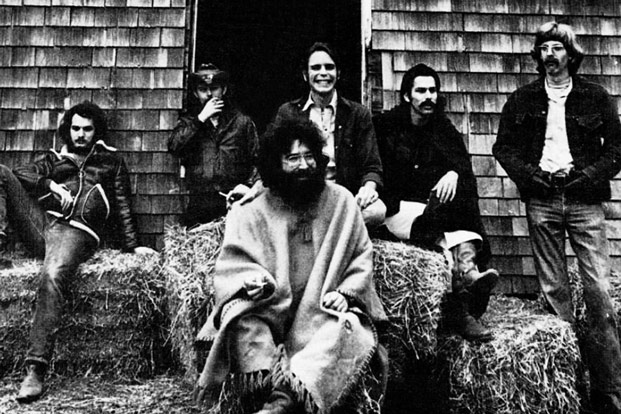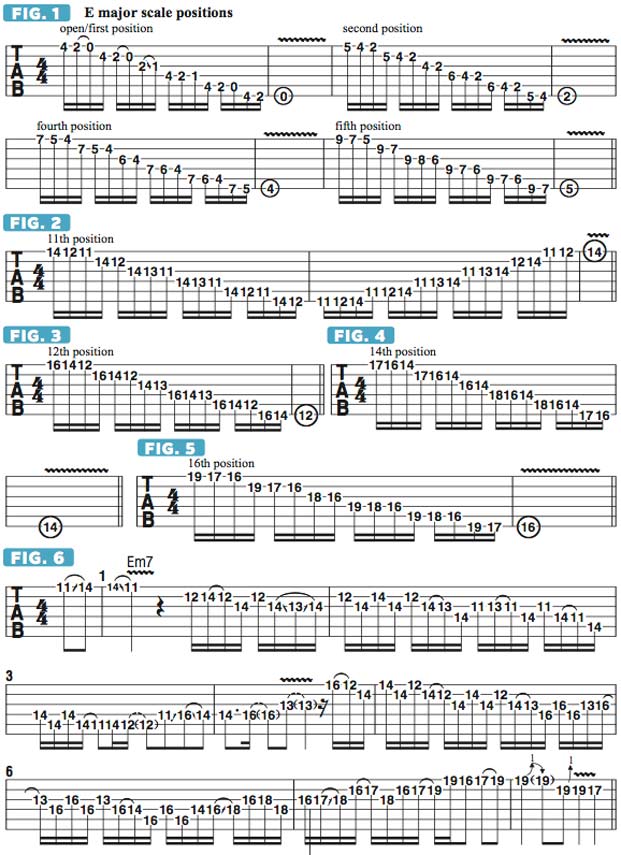Connecting E Major Scale Positions When Soloing on “Eyes of the World”

Grateful Dead leader and guitarist Jerry Garcia is revered as one of the most inventive and unique soloists ever, having forged a distinctive style that is an amalgam of rock, pop, country, jazz, bluegrass, Appalachian folk and more.
His broad musical approach and playing style laid the foundation for the many facets of today’s multi-layered jam music scene.
The Dead’s 1973 classic, “Eyes of the World,” is built on a medium-tempo funk/R&B–style groove over an E major tonality, and Jerry combines E major scale runs with deft use of chromaticism in the tune’s three solo sections. During the intro, he solos over an Emaj7 chord; during the main guitar solo, the progression is Emaj7-Bm7; and during the outro, the progression is Emaj7-Bm7-A. In each solo, Jerry relies primarily on the E major scale, which he plays in virtually every area of the fretboard.
In the previous two columns, I showed you E major scale patterns played in open/first position, as well as second, fourth, fifth, seventh and ninth positions, covering all the standard patterns between the nut and 12th fret. FIGURE 1 offers a quick run-through of most of these positions. If you haven’t already, I encourage you to memorize these scale positions, reciting (and singing) the note and interval names as you play, so that the E major “map” will be crystal clear to you when you look down at the fretboard.
Now let’s expand our study to E major scale positions played higher up the neck. FIGURES 2–5 illustrate the scale played in 11th and 12th, 14th and 16th positions, respectively. You’ll notice that most of these patterns have you fretting three notes per string on all strings except the G string, for which only two notes are played; the exceptions are the fifth- and 11th-position patterns, wherein two notes are played on the B string and three notes are played on the G. A fret-hand stretch is required to finger these scale positions properly, so be sure to keep your hand as relaxed and limber as possible throughout.
FIGURE 6 presents an improvised solo over the Emaj7 groove, focusing on lines that connect the 11th-, 12th-, 14th- and 16th-position patterns of the E major scale. I begin in 11th position and, at the end of bar 3, I slide on the D string to shift up to 12th position. At the end of bar 6, I perform another slide up the D string to move from 14th to 16th position, where I remain for the remainder of the solo.
Review all the E major scale positions I’ve presented, then try devising some solo explorations of your own. In the process, you’ll no doubt discover some interesting and effective ways to connect the various patterns.
In Deep April 2016 FIGURE 1
In Deep April 2016 FIGURE 2
In Deep April 2016 FIGURE 3
In Deep April 2016 FIGURE 4
In Deep April 2016 FIGURE 5
In Deep April 2016 FIGURE 6

Get The Pick Newsletter
All the latest guitar news, interviews, lessons, reviews, deals and more, direct to your inbox!
Guitar World Associate Editor Andy Aledort is recognized worldwide for his vast contributions to guitar instruction, via his many best-selling instructional DVDs, transcription books and online lessons. Andy is a regular contributor to Guitar World and Truefire, and has toured with Dickey Betts of the Allman Brothers, as well as participating in several Jimi Hendrix Tribute Tours.
“There are so many sounds to be discovered when you get away from using a pick”: Jared James Nichols shows you how to add “snap, crackle and pop” to your playing with banjo rolls and string snaps
Don't let chord inversions bamboozle you. It's simply the case of shuffling the notes around








![Joe Bonamassa [left] wears a deep blue suit and polka-dotted shirt and plays his green refin Strat; the late Irish blues legend Rory Gallagher [right] screams and inflicts some punishment on his heavily worn number one Stratocaster.](https://cdn.mos.cms.futurecdn.net/cw28h7UBcTVfTLs7p7eiLe.jpg)


